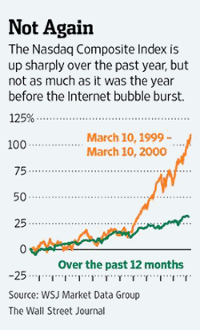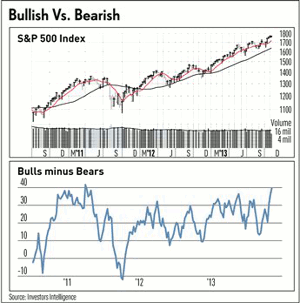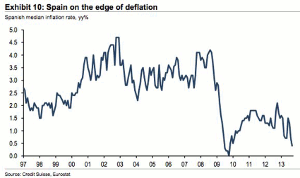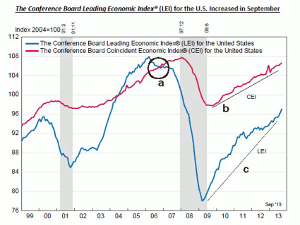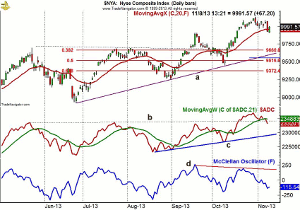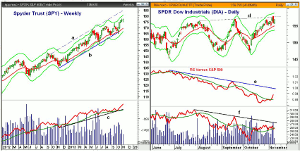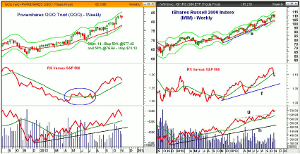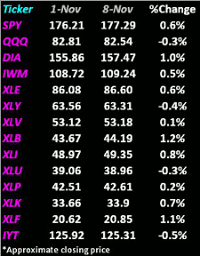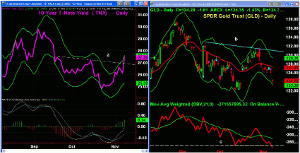Many analysts feel we're witnessing a bubble formation, like that which formed, and burst, in 2000, but MoneyShow’s Tom Aspray shares why he feels it's too early to make that call, given the differences between the two markets.
The long awaited Twitter IPO did better than expected, as it closed Thursday 70.8% above the initial offering price. The S&P futures had turned lower by the opening, and closed very weak. It appeared that someone was paying attention to the financial networks and their segments on whether it was a “stock market bubble.”
This discussion may have been in reaction to comments on October 29, by BlackRock’s Chief Executive Officer Laurence D. Fink, who said “Fed policy is contributing to bubble-like markets, such as the surge in stock prices.” BlackRock manages a reported $4.1 trillion in assets, which makes it the world’s largest money manager.
Two other long-term bulls, Edward Yardeni and Laszlo Birinyi, according to the New York Times, are concerned that the current complacency would lead to a “melt-up” in stock prices. They both think a correction of 10%, or so, would be healthy, as it should set the stage for even higher prices. Edward Yardeni has an S&P target of 2014 for next year.
In my opinion, the last real bubble in the stock market was the dot.com boom that topped in March 2000, when the Nasdaq Composite topped at 5132. It closed Thursday at 3857 and is still 33% below the 2000 high.
The chart above compares the March 10, 1999 to March 10, 2000 period with the past 12 months. It is easy to see that the angle of ascent in 1999-2000 was dramatically steeper than it is now. This is not a bubble.
Clearly, the market is overbought on a near-term basis, as 447 of the S&P 500 are higher for the year. The number of S&P 500 stocks above their 50-day MAs has dropped from just over 80 and is back to the mean of 67. It is not yet oversold, as it bottomed at 35 in October.
One common concern amongst the bears and bubble cap, is the fact that the spread between Investors Intelligence bulls and bears has jumped to 39%. The Option Strategist’s Larry McMillan points out that this is a “huge number.”
As most know, this a contrary indicator, as when too many are bullish, there is theoretically no one left to buy. Conversely, when bearish sentiment is too high, everyone has sold and no one wants to sell. The chart from Investor's Business Daily shows that the last higher reading of 41.4 was reached on April 8, 2011.
In April 2011, the S&P corrected 3.3% from the highs, and then rallied 5.8% from the lows to make a new high on May 2. The S&P 500 declined 21.5% over the next ten months, as it bottomed in early October.
Using the ineffective 20% measure, stocks were in a bear market which turned the sentiment even more bearish. At the market low, the spread had reversed, as there were 10% more bears than bulls, and the daily advance/decline lines indicated a market low was in place.
On the economic front, there were several surprises last week. Most expected that the ECB would leave rates unchanged, but instead, they lowered rates by 0.25%. This was in reaction to the low rate of inflation, which is well below their target zone of 2%. The chart below of Spain’s inflation rate illustrates their problem. It was over 4% in 2008 and is now at 0.3%.
Interest rates in the Eurozone are still higher than those in the US, so it is not clear that this action will weaken the euro enough to stimulate their economy, but that is the hope.
NEXT PAGE: What to Watch
|pagebreak|
One economist, Lakshman Achuthan, who is the co-founder of the Economic Cycle Research Institute said on Bloomberg that the US had already entered a recession in 2012. This was in contrast to the better than expected ISM Non-Manufacturing Index last week, and the solid reading on the Conference Board’s Leading Economic Indicators. It has a solid record of warning of impending recessions.</p >
Both the coincident and leading indicators are still in solid up trends, line a, and c, showing no signs of topping out. In early 2007 (see circle), the LEI dropped below the CEI and was in a solid downtrend before the end of the year.
The delayed jobs report for October was also much better than expected by most economists, as there were almost 70,000 more jobs than most economists expected. Next month’s reading is likely to be more important.
With banks closed Monday for Veteran’s Day, the first real report is the Treasury Budget on Wednesday afternoon. The International Trade and jobless claims are out on Thursday, in addition to Productivity and Costs.
Then on Friday, we get the Empire State Manufacturing Survey, import and Export Prices, as well as the latest reading on Industrial Production.
What to Watch
Since the October 29 high of $111.62 in the iShares Russell 2000 (IWM), it has dropped 4% to last Thursday’s low of $107.14. The Powershares QQQ Trust (QQQ) has dropped 2.5% from high to low, but has held well above the September highs.
There are no signs of a weekly top from the technical studies, while the daily analysis varies depending on the market segment, as the Spyder Trust (SPY) and SPDR Dow Industrials (DIA) have held up better.
This makes the action early in the week important, as, if stocks can stabilize and rally further, it will suggest that the brief correction is already over. Conversely, a sharply lower close on Monday or Tuesday could generate more daily sell signals. A deeper correction would help further relieve the market’s overbought status and the too high bullish sentiment.
So what should you be looking to buy? In last week’s analysis of stocks in the Dow Industrials there were several on the most oversold list that looked good to me at lower levels. There are others in the industrial sector that I am watching, as quite a few are still trading near the recent three to four week lows.
One part of this sector, the homebuilders, look as they are still going to move lower before a bottom is complete. I will be watching for new buy signals in the next few weeks. It has been a good past month for the portfolio, but I continue to advise taking profits on strength and raising your stops with prices.
The daily chart of the NYSE Composite shows that it has corrected steadily from the October 30 highs, and at last Friday’s lows had corrected just over 2%. It is already back to the September highs, but did close Friday back above its 20-day EMA.
There is additional support now at 9660, which is the 38.2% Fibonacci retracement support from the June lows. The quarterly pivot is at 9558, with the uptrend, line a, a bit higher. The 50% retracement support is at 9515, with the weekly starc- band at 9530.
Both the weekly and daily NYSE Advance/Decline broke out to the upside in October, but the daily has dropped below the breakout level (line b). It is also below its WMA and needs a strong day of A/D ratios to reverse to the upside. The A/D line has more important support at the uptrend, line c.
The McClellan oscillator did diverge from prices at the recent high, line d, and hit a low of -136 last Thursday. So far it has held above the early October low at -192 and is trying to turn higher.
A decisive close above the last swing high at 10,083 would be the first sign that the correction was over.
NEXT PAGE: Stocks
|pagebreak|
S&P 500
It’s hard to tell on the weekly chart but the Spyder Trust (SPY) made a marginal new high at $177.64 last Thursday before reversing to the downside. On Friday it was able to hold above the Thursday lows at $174.76 and the 20-day EMA at $174.73.
The September high is at $173.61, with the monthly pivot at $172.60. The 38.2% Fibonacci support from the June lows is in the $170 area.
The weekly on-balance volume (OBV) has made convincing new highs over the past month and continues to act strong. It tested its WMA and support, line c, in October. The daily OBV (not shown) did confirm the recent closing high and has turned up from its WMA.
The daily S&P 500 A/D line (not shown) also made a new high, before dropping below its WMA last week. It did close the week back above its WMA.
The daily starc+ band is now at $178.98 and the weekly is at $180.89. The upper boundary of the trading channel is at $184.61. A test of this level could be the "melt-up" some are worried about.
Dow Industrials
The daily chart of the SPDR Dow Industrials (DIA) shows the marginal new high, line d, as the Industrials confirmed Monday’s high in the Transports. This reaffirms the positive Dow Theory outlook. The weekly starc+ band is now in the $160 area.
So far, DIA has held above the 20-day EMA and the recent low at $154.87. The reversal from the new highs keep the trading range from June still intact.
The daily relative performance topped out in the spring but is now finally trying to turn higher as it has moved above its WMA. There is further resistance at the downtrend, line e. The weekly RS line (not shown) is still well below its declining WMA.
The daily OBV is above its WMA, but still shows a pattern of lower highs. In contrast, the weekly OBV made strong new highs last week and is well above its WMA.
The Dow Industrials A/D line (not shown) has held above its WMA on the rent market correction, but needs to move above the September and August highs to signal that the Dow is becoming a market leader.
Nasdaq-100
The PowerShares QQQ Trust (QQQ) failed to surpass the prior high at $83.49 last week, before dropping sharply as the biotech stocks were hit pretty hard. Friday’s close was back above the 20-day EMA at $81.88.
The weekly chart shows that a doji was formed the prior week with a low at $$82.38, but a weekly LCD was not triggered on the close. It still could be triggered in the next two weeks, so it should be monitored closely.
The monthly pivot is at $80.88, with support from the September and early October highs at $79.58-62. The 38.2% retracement support from the June lows is at $77.95, with the quarterly pivot at $76.92.
The weekly relative performance formed a nice bottom last summer (see circle), and continues to indicate that the QQQ is an outperformer, as it is well above its rising WMA. The daily RS line (not shown) does show some loss of upside momentum.
The weekly OBV shows a pattern of higher highs, and though it has turned down, it is well above its strongly rising WMA. The daily OBV analysis is also positive.
The Nasdaq 100 A/D line (not shown) has dropped sharply after confirming the late October highs. It has turned up from below its WMA, as it did test the support that goes back to the August-September highs.
Russell 2000
The iShares Russell 2000 Index (IWM), after just exceeding the quarterly R1 at $111.37, triggered a daily low close doji on October 30, as IWM quickly dropped $5 from its high. The IWM stabilized Friday, closing back above the monthly pivot at $107.94.
On the weekly chart this does not look significant, as IWM is still well above the rising 20-week EMA at $104.87. This is just above the quarterly pivot at $104.41. Remember, this is an important level to watch on a weekly closing basis. There is initial resistance at $110.40 and a close back above this level could turn the short-term momentum positive.
The weekly relative performance bottomed in early 2013 and has since formed a strong uptrend. It did confirm the recent highs before dropping below its WMA. It could form a divergence if IWM makes a new high.
The weekly OBV surged above its previous high, line g, in October and continues to act strong. It is well above its WMA while the daily OBV has dropped sharply and violated the October lows. Therefore it could form a negative divergence if the recent highs are exceeded.
The Russell 2000 A/D line (not shown) has dropped down to test the uptrend from the late 2012 lows and is now well below its WMA, which is declining. Therefore, strong A/D numbers are needed on the next rally or it will suggest that the small-caps are giving up leadership.
NEXT PAGE: Sector Focus, Commodities, and Tom's Outlook
|pagebreak|
Sector Focus
The iShares Dow Jones Transportation (IYT) closed the week lower, as first support at the late October lows and the 20-day EMA were tested. It did make another new high early in the week before the sellers took over.
The weekly technical studies are positive, and did make new highs two weeks ago, but have turned lower. The daily studies, including the OBV did confirm the recent highs so the multiple time frame OBV analysis is positive.
Of the fourteen ETFs in the table below, ten were up and only four were down for the week, as the surge of late buying really helped. The Select SPDR Materials (XLB) did the best, up 1.2%, with the Select SPDR Technology (XLK) also higher for the week.
The SPDR Dow Industrials (DIA) did the best of the four sector ETFs, as it gained 1.0%, and the Sector Select SPDR Industrials (XLI) gained 0.8%. The Sector Select SPDR Financials (XLF) also liked the prospect of higher yields and gained 1.1% for the week.
The Select SPDR Consumer Discretionary (XLY) was down 0.3%, while the Select SPDR Health Care (XLV) finished barely higher. These are the two sector ETFs that have the best long term charts.
Dollar Index: The dollar index had its highest weekly close in the past six weeks, as the ECB rate cut did not hurt. The weekly OBV on the futures has moved above its WMA, suggesting that an important low could be in place.
Crude Oil
Crude oil was just a bit lower last week, as prices are trying to stabilize. Both the weekly and daily OBV are negative but the daily is acting sold out.
Interest Rates: The yield on the 10-year T-Note surged Friday in reaction to the much stronger than expected jobs data. The close above the October high, line a, does suggest that the pullback in yields may be over, as the taper talk has begun again. The daily MACD-His has also turned positive.
Precious Metals
The Spyder Gold Trust (GLD) gapped lower Friday, and the daily OBV has closed below the key support, at line c. This suggests that prices will break the October lows, closing the bull trap, as I discussed in more detail last week.
The Week Ahead
It was sort of a wild ride last week as, in addition to the widely anticipated Twitter IPO, the ECB and jobs data also surprised the markets. Though rates moved up on the thought that the Fed could start tapering before the end of the year, the data is likely to be adjusted further next month.
Those considering the stock market have had the worst time, as I noted earlier, some are looking for the S&P 500 to hit 2014 next year (a gain of 14% from current levels), others are warning of a bubble.
The Financial TV media is almost starting to act like a contrary indicator and, as I suggested in my advice from early in the year, learn to be your own analyst. Of course, that will take some work, but if you are serious, you should commit a few hours over the weekend to review your positions and to plan your strategy.
Though I do not yet see a 10% correction on the horizon, one is pretty much inevitable by early 2014. The goal should be to reduce your positions on strength, and raise cash so you will be better prepared to buy, once the correction is over.
I am continuing to look for good buy candidates, for those who have been following my recommendation during the year, but the risk is higher for those just now moving into the market. For those who are not in the market, I continue to suggest the dollar-cost-averaging strategy that I discussed in early August’s column It's Never Too Late to Build a Portfolio.
We are still in the process of implementing the dollar-cost-averaging strategy in the Vanguard FTSE Emerging Markets ETF (VWO).
If I see significant change in the market next week, I will let you know in my daily column and on Twitter.
Don't forget to read Tom's latest Trading Lesson, Profiting From Multiple Time Frame Sector Analysis.
Editor’s Note: If you’d like to learn more about technical analysis, attend Tom Aspray’s workshop at The Traders Expo Las Vegas, November 20-23, 2013. You can sign up here, it’s free.

